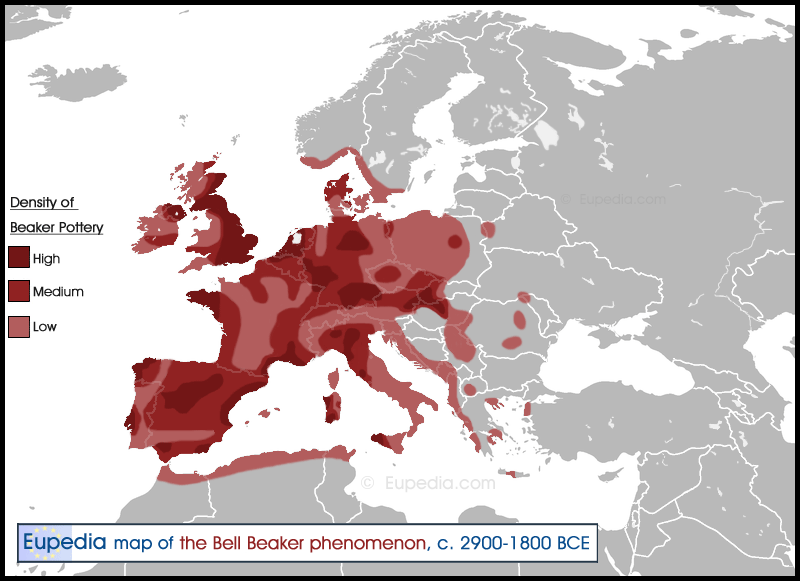But your sources are vague. Indirect and nothing conclusive. I wouldn't rush so much IMO. Initially i would generalize the region then when we have more facts we can scope it down to specific culture if that really happened.
I brought up some papers dealing with that specifically. The Middle Danubian expansion had nothing to do with the Channelled Ware ceramic and customs. If talking about the name giving ceramic alone, the predecessors all belong to the Pannonian local cultures which were pushed by the invading Tumulus culture. Like Otomani-F?zesabony. Also the very direct predecessors of Channelled Ware groups, like Berkesz and Piliny. You can read up on those, they had nothing to do with the TC invaders. Even when they themselves joined the TC network, probably under pressure, when being forced to the Upper Tisza region, where all the refugees and locals amalgamated to something new = Channelled Ware. For this process and development, the Middle Danubian TC groups were rather a push factor, but not the creators themselves.
Surely they influenced each other, but for G?va-Kyjatice its more about groups like F?zesabony and the direct ancestors Piliny -> Kyjatice and Berkesz-Demecser -> G?va.
If you go back in time, important cultures are always F?zesabony-late Otomani and even older Ny?rs?g, the latter occupy exactly the later G?va core region:
Almost all locations of the Ny?rs?g culture lie in the north-east Hungarian lowlands and the neighbouring regions in north-west Romania and east Slovakia.
http://www.donau-archaeologie.de/doku.php/kulturen/nyirseg_english_version
The sites in question for the earliest phase of Berkesz, Ny?rs?g and Demecser are all very close in the North East of Hungary, in the classical triangle of Hungary-Slovakia-Romania. And they being connected with Proto-Thracians even before:
A. Mozsolics made an important statement according to which the finds of Ny?rkar?sz?Gyulah?za are c?osely linked with the material of the areas east of the Carpathian Basin by the tumulus burials and by a few bronze types (e. g. wart-necked pin, the socketed celt of the Transylvanian type) and the parallels of several bronze finds from Ny?rkar?sz?Gyulah?za occur in the hoards coming to light in Eastern Hungary. 8 These results are supported by several proofs in her article evaluating the hoard of Op?lyi. According to her final conclusions numerous hoards were put into the earth in the second half of the В IV period mainly in Szabolcs-Szatm?r County (Hungary), in the Carpathian Ukraine and in the area of Northern Transylvania which included several objects in common and the material from the tumulus of Ny?rkar?sz (Felsőszőcs culture) 9 provide important aid in dating those finds. According to I. Bona the eastern forms appearing in the pottery and metallurgy of the eastern part of the Carpathian Basin in the 12th century was the result of the immigration from the East which affected the whole area of Transylvania and the Great Hungarian Plain. (With the exception of the daggers of eastern type he treats these only in general.) In his opinion, in a ?transitory period" ? a term he coined for Late Bronze Age 3 ? (R BD ? HA,) a Thracian population (the ethnic group represented by the cemeteries of Muhi, Berkesz, Demecser) invading from the East culturally superseded the Egyek cultural group. It is important for us that he by collecting parallels determined the age and eastern origin of the dagger found at Berkesz ?Csonk?sdűlő. 1 0 In brief, from the quoted opinions it is clear that both Mozsolics and Kalicz noted that some of the finds of the Felsőszőcs culture (called by Kalicz the Felsőszőcs group) is younger than the Felsőszőcs pottery with deeply incised decorations, but they still treated as part of one cultural unit the material which in reality was only genetically related. The cause of this seems that Mozsolics did not take into consideration several assemblages of finds from the Ny?rs?g (in particular those typical of Berkesz ? Demecser) while Kalicz discussed only those pieces of these assemblages of finds which closely resemble in form the Felsőszőcs types. Thus he neglected those which primarily prove that the inheritace of other ethnic components is traceable in the material of several cemeteries (e. g. Berkesz, Demecser, Ny?regyh?za? Bujtos).
A. Mozsolics and I. Bona also emphasized the eastern relations or origin of the Felsőszőcs culture (on the basis of the Ny?rkar?sz?Gyulah?za finds) or that of the Thracian ( ?) population indicated by the Muhi? Berkesz ? Demecser cemeteries.
The fact that those hoards which mark the end of the life of the Berkesz-Demecser ethnic group 106 were hidden in the earth indicates an outside attack. As it is commonly held, the inheritance of the invaders are the finds of the
G?va 107 type among which several ceramic forms occur which have their roots in local development. 108 Among the hoards which were buried in the Early Iron Age there are also several metal types of local origin. This indicates that a considerable part of the population did not move. It can be surmised that the path of those compelled to flee is traceable in the material of a few graves unearthed in the cemetery on the outskirts of Soldanesti.
https://library.hungaricana.hu/hu/view/FoliaArchaeologica_18/?pg=29&layout=s
The picture is complex, but there is no way around that triangle for Channelled Ware/G?va. It also proves why there were no finds of E-V13 in the Early and Middle Bronze Age from most of Pannonia, but, if we are lucky, only from the very North East, at the end of the period: Because they came there just late probably.
Cultural formations which should be remembered, also for future sampling, are Berkesz, Demecser, Egyek group, Ny?rs?g group among others. All pretty much in the same region of the triangle, all related sites and groups, but with newcomers influencing and transforming them in part or fully, which is not yet fully understood, just like the true origin of G?va in this context remains elusive.




